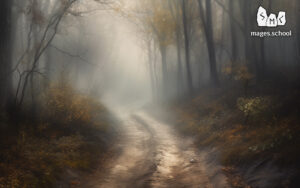Lughnasadh
(Lammas)
August 1st. The waning of the Air element.
The period from the Summer Solstice of Kupala to the next transition point, Lammas is the time when all the elements are at their maximum. It is the most propitious time for the growth of the young force, this is the time of the god’s healthy childhood. There is no need for anything, all the Forces are in abundance and concerted with each other. But eventually, everything comes to an end, and so is childhood. The young god enters a stage of maturity and becoming which means that the time of trials is upon him.
The first test that the young force has to overcome together with the people, the carriers of such force, begins on the day and time when the force of the Air Element starts leaving the space of the primordial forces. August 1 – Lammas, or Lughnasadh. Air begins to fall asleep – exactly 6 months after its awakening on Imbolc. The reverse processes begin, and from that point on all other elements are forced to assume the functions that air performs in the magical currents of power – direction and control. Are they up to the task?
 In a way, this day becomes the day of summing up. However, everyone’s outcomes are defined by the tasks, expectations, and needs that were identified earlier. Akin to a young man who at the moment of entering adulthood, still can not answer the question, “What have I done in this life?” – but is capable enough to answer. “What do I want to do?’” Rightfully so, for people- Lammas is a holiday of harvesting because the harvest is the result, the result of sowing that was done sometime before, which allows us to determine the quality of the seed. Now it’s important to preserve it, not ruin it, and protect it. It is important to distribute the results correctly so that there is enough for a long winter as well as for future crops.
In a way, this day becomes the day of summing up. However, everyone’s outcomes are defined by the tasks, expectations, and needs that were identified earlier. Akin to a young man who at the moment of entering adulthood, still can not answer the question, “What have I done in this life?” – but is capable enough to answer. “What do I want to do?’” Rightfully so, for people- Lammas is a holiday of harvesting because the harvest is the result, the result of sowing that was done sometime before, which allows us to determine the quality of the seed. Now it’s important to preserve it, not ruin it, and protect it. It is important to distribute the results correctly so that there is enough for a long winter as well as for future crops.
Despite the fact that the harvest is actually still ongoing, it was on the day of the leaving Air, the old-time mages took people out for ‘”a farewell to the summer.” Standing on top of the hill, each member of the ceremony thanked Mother Earth for the gifts received and accepted. Everyone, anticipating the imminent approach of winter, on this day and time understood: soon it will be the time to reap the fruits of what has been done. Until the force of Air returns to the visible world, which will happen on Imbolc, there will be no opportunity to change the already formed future: what is done is done.
The power of the young god is being tested by the outside world.
He will have to confront other gods and fight in a battle against chthonic forces – not on the grounds of enmity, but only to toughen up in order to become the best. If he succeeds in all the ritual trials, his transformation and makeover will take place, and he will be the one to become the Mighty God of Everything who will be summoned by Mother Earth next spring, on the Night of Beltane, the Night of the Thousand Fires. The people who carried within themselves the fire of the one Who-Is-Destined-To-Be foresaw the challenges ahead. This day was as important to them as the day of maturity. In the midst of the still raging nature and abundance of fruits, with extreme acuity they were aware of the inevitability of their Path, understanding that Orlog is not just a word, Orlog truly exists. Our ancient ancestors firmly believed in their destiny. But the worldview of a person of that time, the time of the Old Gods, made it possible to distinguish between two kinds of destiny – Vird and Orlog. Vird is a personal fate and depends only on the actions and will of a person. Orlog is different, it is not the fate of a person but God.
But if a person is firmly connected to his god, his fate becomes their common: Vird can no longer stay away from Orlog, the fates of the two are woven together in the same pattern. Considering that tribe or kin usually were connected with a certain deity (pantheon), the researchers began to interpret the term “Orlog” as “collective fate” (or karma of a kin, people’s karma). This is also true, not as a cause but as a consequence. The reason lies in the connection between the fate of a person and God. Orlog is the path one should walk through. It is not “possibly,” not “likely,” but it is precisely necessary. Perceiving it neither as a retribution nor blessing, neither as a punishment nor encouragement, our forefathers did not divide fate into good and evil. Roughly speaking, Orlog is a road, and Vird is the shoes that come in contact with it. You didn’t build the road, so you probably don’t know its length or direction. But shoes are something made (obtained) by you, it is something you are responsible for. Vird, akin to a traveler’s shoe, can make a trip easier, or can constantly interfere with the path of your own Orlog.
Standing on top of a hill under a bright sun, together, shoulder to shoulder, embracing the expanses of the native land as far as possible, all members of a tribe, community, or kin felt keenly that they were on the verge of change. The childhood of the mind has ended as did the childhood of the god with whom their destinies have now been intertwined, akin to the ears of a sheaf of wheat that stood as a symbol at the edge of the field. Men and women, young and old knew that the trials that fate had ordained them, were the trials for God. But it is precisely on how one passes these trials that the fate of God will be formed; his victory is their victory, everyone’s success and strength are the spikes within a big sheaf of bread; it is the support that will help to survive the “dark times” – the time when one kind of force transforms into another.
Of course, as time passed, the sacral meaning of the first sheaf and the ritual ascent of the hill at 3 o’clock in the afternoon was lost. Only the memory of the necessity of such action was left. It is necessary to stand at the threshold. It is necessary to raise your eyes to the sky and hold them on the sun. We must thank Mother for her gifts, strength, and life. It is like a blessing from her before the long journey of trials. And this blessing must be received.
According to the legend, the young god went on a journey, “followed the wind,” followed the leaving air. Translating from the language of the legend, we see that from this point on a journey for knowledge, for experience begins. The experience can not be gained by sitting on a couch, and the realization of one’s Orlog is akin to a guiding thread, like a magic tangle, which leads youth down the road of trials.
The druids and volhvs, as they put the air element to rest, watched as the veil between the human world and the spirit world became denser. At that moment, the seers saw clearly the Orlog of the entire tribe, the path of God, they saw the trials that everyone must overcome so that the power that nourishes the tribe will not run out and will definitely return to them. In order to help all the people not only survive the difficult times of trials but also to protect the tribe from their own human weaknesses, the mage looked at them as a bound sheaf of ears, at the area it could fall apart, where the ears were not tightly aligned to each other, – they saw the vulnerabilities. Therefore, during Lammas, ritual weddings took place that were meant to bring people closer together; geas and vows were taken, all of which were meant to reinforce the inner strength of the tribe. It was wise not to argue with the mage: everyone knew what he saw further.
The Slavic folk did not really allocate this transition with separate rites because, in the Slavic land, the harvest was in full swing. But at the very beginning of August, the volhvs tried to tell the future by the passing wind while sending the words along with it calling out to Stribog, the god of the winds. Through it, the volhvs listened to the breath of the world and spoke to the gods. The Rusichs called themselves Stibog’s grandchildren and believed that the spirit of the Russian warriors, defenders of the land, was strengthened by the wind of Stribog.
The magical meaning of the transition on the Day of Lammas is the understanding of one’s own strength and the conscious refusal of anybody’s help. It is a necessity not to let in the “foreign wind,” but to wait for your own. A foreign wind can take you away from your path, mix up your direction, make you forget your dream, and betray your faith. From now on there will be a trial of endurance and understanding, it will only be more difficult moving forward.
Excerpt from the book “Health through the Power of the Elements” by Ksenia Menshikova.
************************************************************
Other pagan holidays of the Weel of the Year:
1 Imbolc 2 Ostara 3 Beltane 4 Litha (Kupala) 5 Lughnasadh (Lammas) 6 Mabon 7 Samhain 8 Yule
************************************************************
